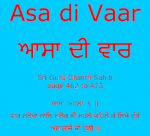Template:AOW173: Difference between revisions
Hari singh (talk | contribs) No edit summary |
Hari singh (talk | contribs) No edit summary |
||
| Line 3: | Line 3: | ||
{{pm|image:Asa di Vaar graphic 2.png|''ballad of hope''}} | {{pm|image:Asa di Vaar graphic 2.png|''ballad of hope''}} | ||
'''ASA KI VAR''', is the term recorded in the index to the [[Guru Granth Sahib]] but this [[Gurbani]] is commonly called ''"[[Asa di Var]]"''. It is found in the [[Sikh scripture]] from [http://www.srigranth.org/servlet/gurbani.gurbani?Action=Page&Param=462&english=t&id=20880#l20880 page 462 line 17 to page 475 line 10]. | '''[[ASA KI VAR]]''', is the term recorded in the index to the [[Guru Granth Sahib]] but this [[Gurbani]] is commonly called ''"[[Asa di Var]]"''. It is found in the [[Sikh scripture]] from [http://www.srigranth.org/servlet/gurbani.gurbani?Action=Page&Param=462&english=t&id=20880#l20880 page 462 line 17 to page 475 line 10]. | ||
The composition is by [[Guru Nanak]], the founder of [[Sikhi]] and is usually sung by [[kirtania]] (religious musicians) at [[Sangat|Sikh congregations or gatherings]] as part of the early morning service. | The composition is by [[Guru Nanak]], the founder of [[Sikhi]] and is usually sung by [[kirtania]] (religious musicians) at [[Sangat|Sikh congregations or gatherings]] as part of the early morning service. | ||
Latest revision as of 12:50, 15 January 2011
ASA KI VAR, is the term recorded in the index to the Guru Granth Sahib but this Gurbani is commonly called "Asa di Var". It is found in the Sikh scripture from page 462 line 17 to page 475 line 10.
The composition is by Guru Nanak, the founder of Sikhi and is usually sung by kirtania (religious musicians) at Sikh congregations or gatherings as part of the early morning service.
This Var is a heroic ode which describes the brave deeds of a hero. It is generally sung to inspire armies going to battle or to inspire people with martial spirit. The tempo of this bani when sung is very measured and positive inspiring a spirit of chardikala in the congregation.
The kirtan is very melodious and the style as mentioned by Guru Arjan is called "Tunde Asraje ki Dhuni" after the name of the contemporary brave and pious Indian king Asraj. One of the hands of the king was amputated, so he was called 'Tunda' meaning crippled. .....More

